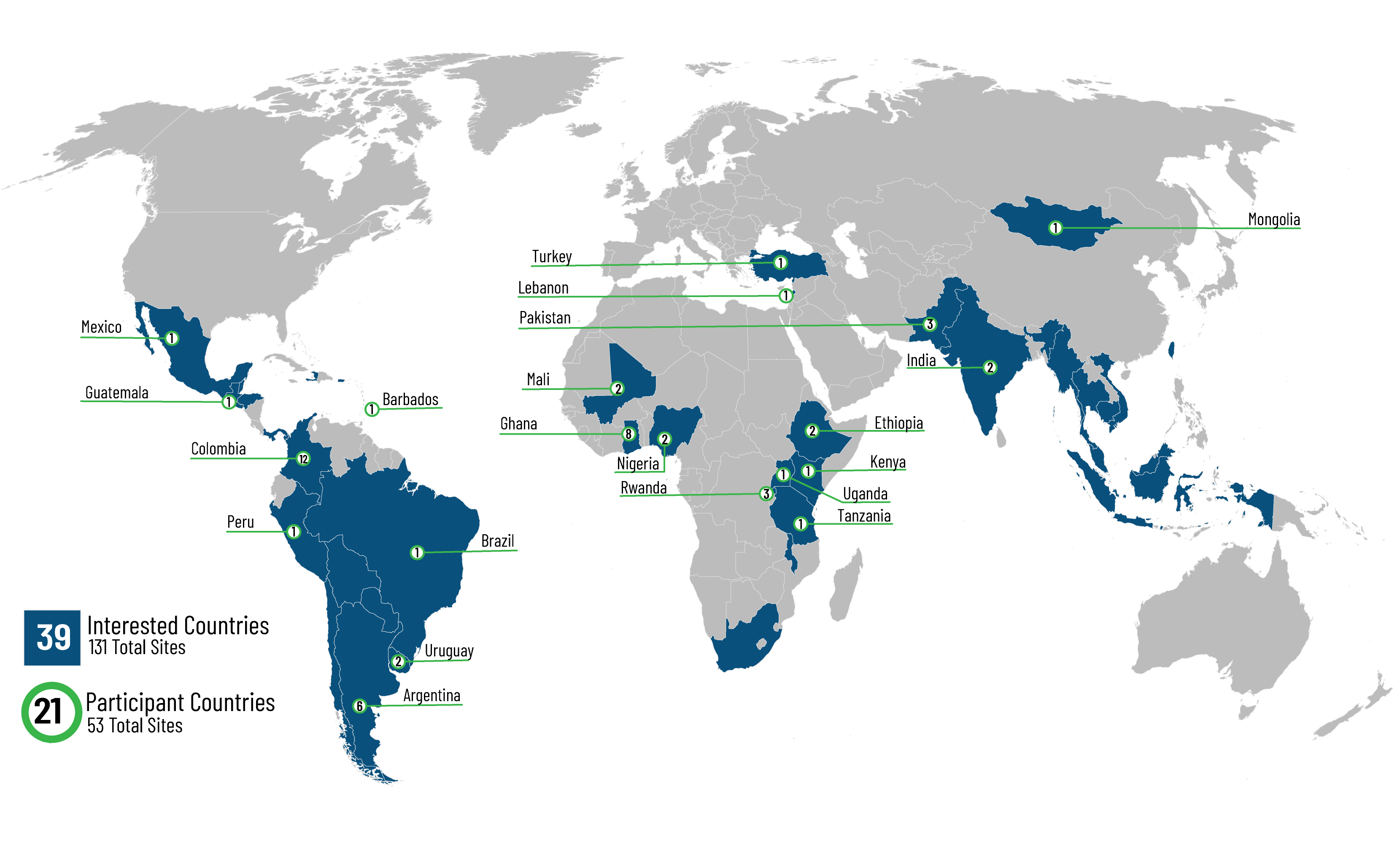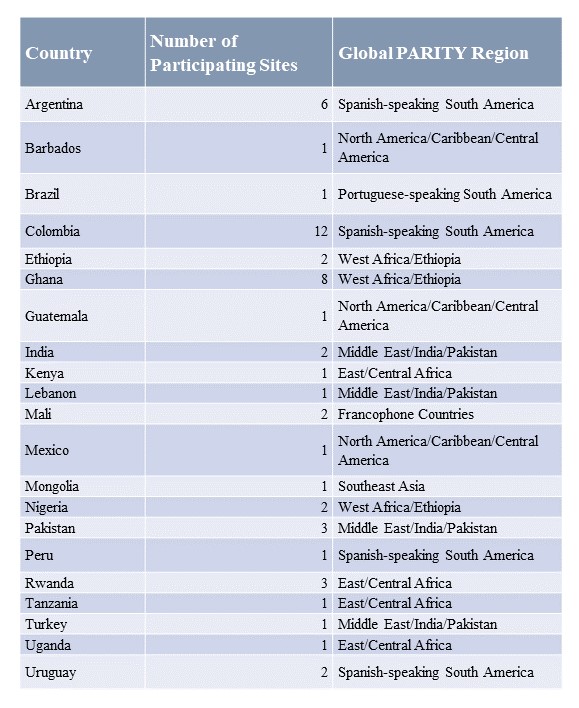Global Neonatal & Children's Health
Category: Abstract Submission
Global Child and Adolescent Health III
527 - Global PARITY: Challenges and Lessons Learned Conducting a Global Point Prevalence Study in Resource-limited Settings During a Pandemic
Sunday, April 24, 2022
3:30 PM - 6:00 PM US MT
Poster Number: 527
Publication Number: 527.318
Publication Number: 527.318
Erika Miller, University of Maryland, Baltimore, Baltimore, MD, United States; Adrian J. Holloway, University of Maryland Children's Hospital, Baltimore, MD, United States; Paula Caporal, Red Colaborativa Pediátrica de Latinoamérica (LARed Network) & Sor Maria Ludovica Children´s Hospital, Argentina, La Plata, Buenos Aires, Argentina; Qalab Abbas, Aga khan University, Karachi, Sindh, Pakistan; Eliana López-Barón, Hospital Pablo Tobón Uribe, Medellín, Antioquia, Colombia; Asya Agulnik, St. Jude Children's Research Hospital, Memphis, TN, United States; Kenneth E. Remy, Case Western Reserve University School of Medicine, Cleveland, OH, United States; John A. Appiah, Komfo Anokye Teaching Hospital, Kumasi, Ashanti, Ghana; Jonah E. Attebery, University of Colorado, Aurora, CO, United States; Ericka L. Fink, UPMC Childrens Hospital of Pittsburgh, Pittsburgh, PA, United States; Jan Hau Lee, Duke NUS Medical School, Singapore, N/A, Singapore; Shubhada Hooli, Baylor College of Medicine/Texas Children's Hospital, Houston, TX, United States; Niranjan Kissoon, University of British Columbia Faculty of Medicine, Vancouver, BC, Canada; Srinivas Murthy, University of British Columbia, Vancouver, BC, Canada; Fiona Muttalib, BC children’s hospital, Vancouver, BC, Canada; Katie R. Nielsen, University of Washington School of Medicine, Seattle, WA, United States; Maria F. Puerto-Torres, St Jude Children's Research Hospital, Byhalia, MS, United States; Karla E. de Sá Rodrigues, Federal University of Minas Gerais, Belo Horizonte, Minas Gerais, Brazil; Firas M. Sakaan, St. Jude Children's Research Hospital, Memphis, TN, United States; Adriana Teixeira Rodrigues, Hospital das Clinicas - UFMG/EBSERH, BELO HORIZONTE, Minas Gerais, Brazil; Amelie von Saint Andre-von Arnim, University of Washington School of Medicine, Seattle, WA, United States; Matthew O. Wiens, University of British Columbia Faculty of Medicine, Vancouver, BC, Canada; David Y. He, Analytical Solutions Group, Inc., North Potomac, MD, United States; Teresa B. Kortz, University of California, San Francisco, School of Medicine, San Francisco, CA, United States; Adnan T. Bhutta, University of Maryland School of Medicine, Ellicott City, MD, United States

Erika Miller, MHS
Research Project Coordinator
University of Maryland, Baltimore
Baltimore, Maryland, United States
Presenting Author(s)
Background: Global PARITY (Pediatric Acute cRitical Illness point prevalence sTudY) was designed to measure outcomes associated with pediatric acute critical illness in resource limited settings. Data collection was hindered by local, regional, and national differences that made a comprehensive study challenging.
Objective: To describe site recruitment strategies, start-up procedures, challenges experienced, and lessons learned during a global point prevalence study conducted during the COVID-19 pandemic.
Design/Methods: Participating sites were recruited via research networks of pediatric critical care physicians including the World Federation of Pediatric Intensive & Critical Care Societies (WFPICCS), Pediatric Acute Lung Injury & Sepsis Investigators Network (PALISI), and Red Colaborativa Pediatrica de Latinoamérica (LARed Network). Site start-up procedures included site coordinator education, research investigator registration for REDCap access, and completion of regulatory training videos. Participating sites were required to submit Institutional Review Board (IRB) approval letters and transfer data use agreements (as required by the site) before completing a sample case study, pilot study, enrollment survey, and hospital resource survey. Data collection was performed online in real time and uploaded later for sites with low internet bandwidth. Feedback on data quality was communicated via weekly webinars and emails between the research management team and site personnel. Study timelines were adjusted periodically to respect cultural and religious holidays observed by global partners.
Results: A total of 131 sites completed study screening. The study was initially planned to launch in July 2020, but was delayed by the COVID-19 pandemic, and successfully launched in July 2021 with 33 sites. By October 2021, participating sites increased to 53 with data for over 3000 subjects and only 2% missing critical variables at first data audit. Between January-October 2021, 87 sites withdrew from the study due to limited internet connectivity (1 site); surge in Covid cases (3 sites); inadequate research staffing (13 sites); minimal IRB funding (4 sites); missed IRB submission deadlines (18 sites); denied IRB approval (1 sites); and/or reasons not communicated (47 sites).Conclusion(s): Despite challenges during a pandemic, a successful global point prevalence study can occur to evaluate health outcomes of critically ill children. Repetition of such studies can measure the quality of critical care received and improve resource allocation for equitable care of the critically ill pediatric population globally.
Figure 1: World Map of Participating Sites
Table 1: Participating Sites by Country and Global PARITY-Designated Region
Objective: To describe site recruitment strategies, start-up procedures, challenges experienced, and lessons learned during a global point prevalence study conducted during the COVID-19 pandemic.
Design/Methods: Participating sites were recruited via research networks of pediatric critical care physicians including the World Federation of Pediatric Intensive & Critical Care Societies (WFPICCS), Pediatric Acute Lung Injury & Sepsis Investigators Network (PALISI), and Red Colaborativa Pediatrica de Latinoamérica (LARed Network). Site start-up procedures included site coordinator education, research investigator registration for REDCap access, and completion of regulatory training videos. Participating sites were required to submit Institutional Review Board (IRB) approval letters and transfer data use agreements (as required by the site) before completing a sample case study, pilot study, enrollment survey, and hospital resource survey. Data collection was performed online in real time and uploaded later for sites with low internet bandwidth. Feedback on data quality was communicated via weekly webinars and emails between the research management team and site personnel. Study timelines were adjusted periodically to respect cultural and religious holidays observed by global partners.
Results: A total of 131 sites completed study screening. The study was initially planned to launch in July 2020, but was delayed by the COVID-19 pandemic, and successfully launched in July 2021 with 33 sites. By October 2021, participating sites increased to 53 with data for over 3000 subjects and only 2% missing critical variables at first data audit. Between January-October 2021, 87 sites withdrew from the study due to limited internet connectivity (1 site); surge in Covid cases (3 sites); inadequate research staffing (13 sites); minimal IRB funding (4 sites); missed IRB submission deadlines (18 sites); denied IRB approval (1 sites); and/or reasons not communicated (47 sites).Conclusion(s): Despite challenges during a pandemic, a successful global point prevalence study can occur to evaluate health outcomes of critically ill children. Repetition of such studies can measure the quality of critical care received and improve resource allocation for equitable care of the critically ill pediatric population globally.
Figure 1: World Map of Participating Sites

Table 1: Participating Sites by Country and Global PARITY-Designated Region

